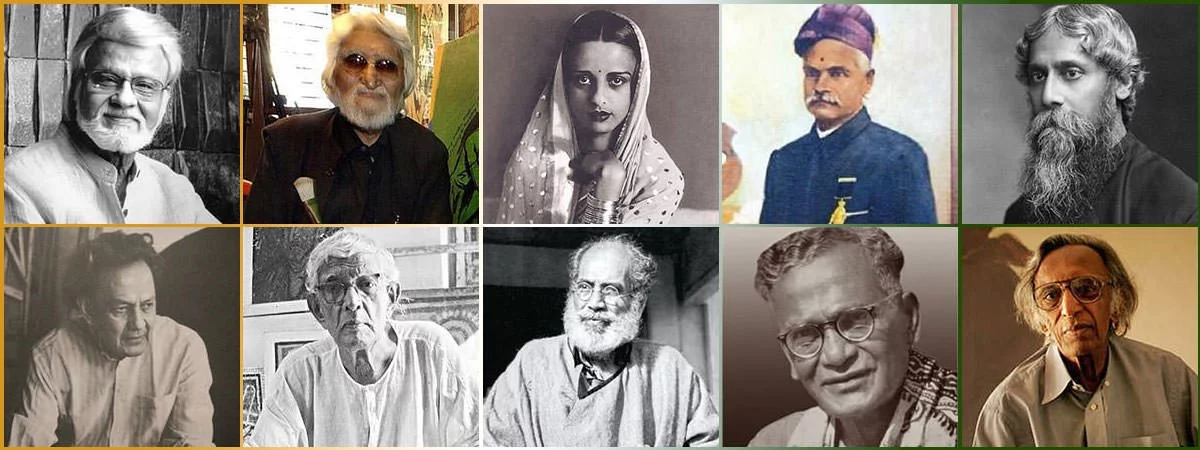
10 MOST FAMOUS INDIAN ARTISTS AND THEIR BEST KNOWN WORKS
Indian art has a rich and complex history spanning thousands of years. However, the artists of ancient India, who created magnificent works like the murals in the caves of Ajanta and Ellora, are not known by name. Among the earliest renowned Indian artists was Raja Ravi Varma, who fused Western artistic techniques with a purely Indian sensibility. British rule and their academic system brought about European influences in Indian art. It was the Bengal School of Art, led by Abanindranath Tagore, that moved the Indian art scene away from western influences and toward traditional Indian art styles. The Progressive Artists’ Group (PAG), which was founded in 1947, then synthesized influences from Indian art history with styles prevalent in the west. It included artists which later achieved international acclaim like S. H. Raza, M. F. Husain and Tyeb Mehta. Many of the artists of PAG ultimately turned to Indian culture to infuse new life in their artworks. Know more about Indian art through the 10 most famous Indian artists and their greatest masterpieces.
#10 TYEB MEHTA

Lifespan: July 25, 1925 – July 2, 2009
A painter, sculptor and film-maker, Tyeb Mehta was part of the Progressive Artists’ Group (PAG) in Mumbai. Here, he interacted with many artists who would later be renowned like S. H. Raza and M. F. Husain. The PAG moved away from the nationalist Bengal school and instead borrowed heavily in style from Western Modernism. Mehta moved to London in 1959 and he stayed there till 1964, after which he visited the New York City. During his time in London, Mehta was influenced by the gruesome distortion of famous British artist Francis Bacon; while in New York, his work came to be characterized by Minimalism. Later, in the 1970s and 1980s, he turned to Indian themes and subjects. When Mehta was young, he witnessed a man being stoned to death and the impact of this incident on him may be seen in several of his disturbing depictions. Mehta’s art has often fetched some of the highest prices paid for Indian artworks at auctions. In 2007, Tyeb Mehta was awarded the Padma Bhushan, the third highest civilian honor in India.
Masterpiece: Kali (1989)
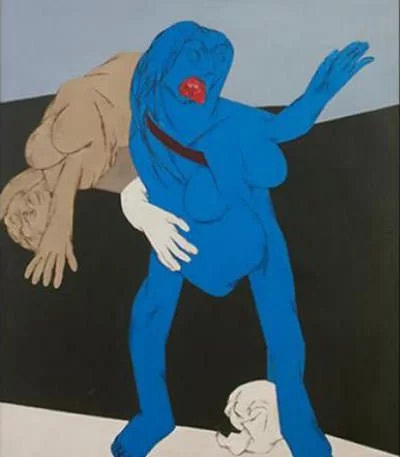
Other Famous Works:-
Mahishasura (1997)
Untitled (Lovers, 1974)
#9 SATISH GUJRAL
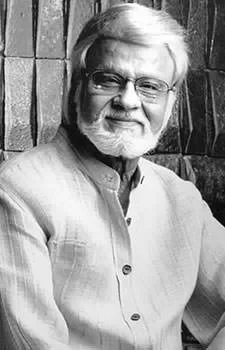
Born: December 25, 1925
Born in Jhelum in pre-partition West Punjab, Satish Gujral joined the Mayo School of Art in Lahore in 1939; and in 1944, he enrolled at the Sir J.J. School of Art in Mumbai. However, in 1947, he had to drop out of school due to a recurring illness. In 1952, Gujral got a scholarship to study at the Palacio de Bellas Artes in Mexico City. Here he apprenticed to the renowned Mexican artists Diego Rivera and David Alfaro Siqueiros. Satish Gujral went on to become one of the leading artists of post-Independent India. From 1952 to 1974, he organized shows of his art in many cities across the world including New York City, New Delhi, Montreal, Berlin and Tokyo. Gujral is known for his diversity as an artist; and he has created works in painting, graphics, mural, sculpture, architecture and interior design. He is also a writer. One of the prominent themes he has explored in his art is the agony faced by the people during the partition of India. In 1999, Satish Gujral was awarded the Padma Vibhushan, the second highest civilian honor in India.
Masterpiece: Days of glory (1952)
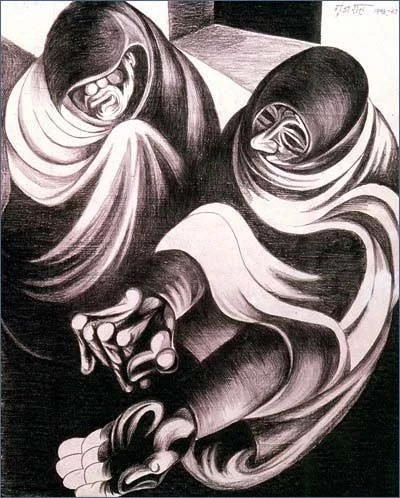
Other Famous Works:-
Mourning en masse (1970)
Tree of Life (1994)
#8 RABINDRANATH TAGORE
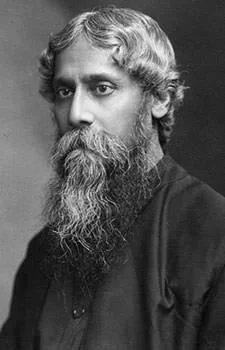
Lifespan: May 7, 1861 – August 7, 1941
Though best known as a poet and as winner of the Nobel Prize for Literature, Rabindranath Tagore was also an artist. He began painting late in his career when he was in his sixties. Though he began by creating doodles, he later produced a variety of images including fantasized and bizarre beasts; masks; mysterious human faces; mystic landscapes; birds; and flowers. Tagore went on to produce thousands of works in art and in 1930, he became the first Indian artist to exhibit his works across Europe, Russia and the United States. The art of Tagore is highly individualistic and is characterized by bold forms, vitality, rhythmic quality and a sense of fantasy. It may be noted that Tagore was likely red-green color blind and this resulted in his works exhibiting strange color schemes and off-beat aesthetics. Rabindranath Tagore was an influential artist and he went on to inspire many modern Indian artists. 102 works by him are listed in the collections of India’s National Gallery of Modern Art.
Masterpiece: Self Portrait (1934)
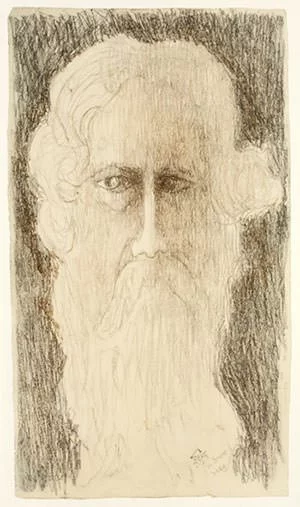
Other Famous Works:-
Dancing Woman (1930)
Head Study (Geometric) (1929)
#7 SAYED HAIDER RAZA

Sayed Haider RazaLifespan: February 22, 1922 – July 23, 2016
S. H. Raza began as a painter of expressionistic landscapes. He moved to France in October 1950 where he continued his experiments with Western Modernism. In the 1970s, Raza grew increasingly dissatisfied with his work. His trips to India, especially to the Ajanta – Ellora caves resulted in his studying the Indian culture more closely. This in turn provided new vitality to his art. In 1980, the “Bindu” (the dot), became a prominent motif in his art bringing him much acclaim. Raza continued with exploring more Hindu themes in his art like the Tribhuj (Triangle) and Prakriti-Purusha (female and male energy). This completed his journey as an artist from a painter of expressionistic landscapes to a master of abstraction. In the 2000s, Raza delved deeper into Indian spirituality creating works around the Kundalini, Nagas and the Mahabharat. In 2010, Raza’s work Saurashtra fetched more than $3.48 million at a Christie’s auction, making it one of the most expensive Indian paintings. In 2013, Sayed Haider Raza was awarded the Padma Vibhushan, the second highest civilian honor in India. In 2015, he was also honored with the Legion of Honour, the highest civilian honor in France.
Masterpiece: Composition Geometrique (2007)
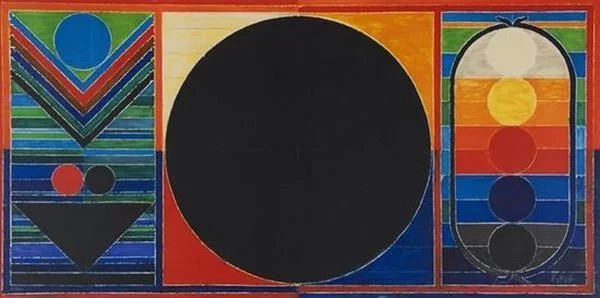
Other Famous Works:-
Saurashtra (1983)
Ankuran (1987)
#6 NANDALAL BOSE
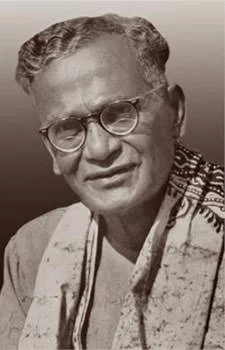
Lifespan: December 3, 1882 – April 16, 1966
Known as the Artist Laureate of India, Nandalal Bose was one of the pioneers of modern Indian art and a key figure of Contextual Modernism. As the movement for independence raged on in India, Nandalal Bose, along with other prominent artists, worked towards moving the Indian art scene away from western influences that had been prevalent in art schools of the time. Instead of western art, Bose was highly inspired by the 5th century murals in Ajanta Caves and he heavily borrowed themes and motifs from them. He also traveled extensively through India paying attention to the various Indian art forms. When India achieved its independence, Nandalal Bose was asked by the Prime Minister of India to sketch the emblems for the awards of the Government of India, including the Bharat Ratna, the highest civilian honor in India. He also performed the historic task of decorating the original manuscript of the Constitution of India. In 1954, Nandalal Bose was awarded the Padma Vibhushan. After his death, in 1976, Indian Government declared the works of Bose to be henceforth considered “to be art treasures, having regard to their artistic and aesthetic value”.
Masterpiece: Bapu, Dandi March (1930)

Other Famous Works:-
Darjeeling and Fog (1945)
New Clouds (1937)
#5 ABANINDRANATH TAGORE
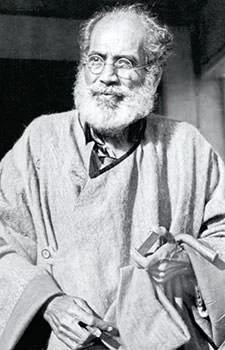
Lifespan: August 7, 1871 – December 5, 1951
A nephew of the famous poet Rabindranath Tagore, Abanindranath studied art at the Sanskrit College in Kolkata. He went on to become the first major modern exponent of Swadeshi (native) values in Indian art. Abanindranath Tagore rejected the “materialistic” art of the west and instead focused on Indian traditional art styles like the Mughal and Rajput styles. He created art which modernized the traditional Indian art forms to counter the influence of the west, as taught in art schools under the rule of the British. Such was the success of his work that even British art institutions accepted and promoted it as Indian oriental art. Abanindranath Tagore also founded the Bengal School of Art, which originated in Bengal and flourished throughout India. The most famous work of Tagore is Bharat Mata, which depicts Bharat Mata or “Mother India” as a Hindu Goddess; and is one of the earliest visualizations of the concept. Abanindranath Tagore was is regarded as one of the most important Indian artists and he had a deep influence on succeeding artists some of whom were his students, like Nandalal Bose.
Masterpiece: Bharat Mata (1905)
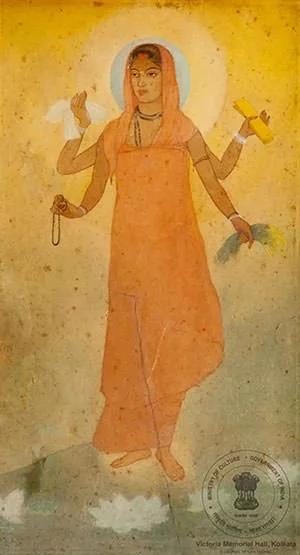
Other Famous Works:-
Ganesh Janani (1908)
Asoka’s Queen (1910)
#4 JAMINI ROY
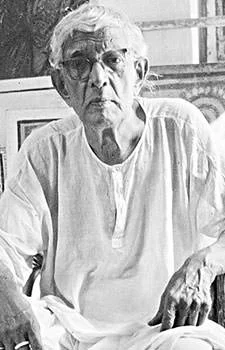
Lifespan: April 11, 1887 – April 24, 1972
Jamini Roy began his career as a painter of Post-Impressionist landscapes and portraits. The European influences in his art were much in keeping with his training in a British academic system. However, in mid-1920s, Roy completely changed his style from his academic Western training to a new style which was based on Bengali folk traditions. Consequently, his techniques as well as subject matter was influenced by traditional art of Bengal. Through his art, Jamini Roy primarily aimed to capture the simplicity in the life of the folk people. He also wanted to make art accessible to a wider section of people and to give Indian art its own identity. Jamini Roy was most influenced by Kalighat painting, an Indian style of art with bold sweeping brush-strokes. The Santhals, tribal people who live in the rural districts of Bengal, were an important subject for him. Jamini Roy was among the leading Indian artists of his time and he had a deep and profound influence on Indian Modern Art. In 1955, he was awarded the Padma Bhushan by the Government of India.
Masterpiece: Mother and Child (1921)
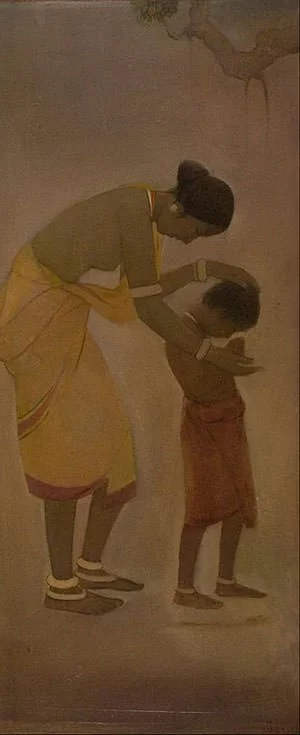
Other Famous Works:-
Three Pujarins
Krishna
#3 AMRITA SHER-GIL
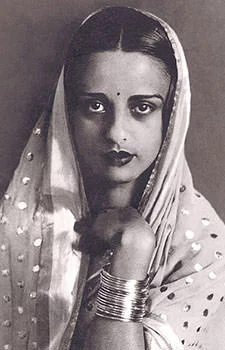
Amrita Sher-GilLifespan: January 30, 1913 – December 5, 1941
Amrita Sher-Gil moved to Europe when she was 16 years old and her early work is significantly influenced by European art style, especially that of Impressionist painters like Paul Cézanne and Paul Gauguin. Sher-Gil first received recognition at the age of 19 through her painting Young Girls. It won her many accolades including a gold medal and election as an Associate of the Grand Salon in Paris. She was the youngest ever member and the only Asian to have received this recognition. As she grew, Sher-Gil made a conscious attempt to return to classical Indian art and it was in Indian subjects that she found her ‘artistic mission’ which was, according to her, to express the life of Indian people through her canvas. Amrita Sher-Gil died at a young age of 28 at the peak of her career. Still, she influenced generations of Indian artists from S. H. Raza to Arpita Singh. Amrita Sher-Gil is regarded as a “pioneer” in modern Indian art and she has been called “one of the greatest avant-garde women artists of the early 20th century”. The Government of India has declared her works as National Art Treasures.
Masterpiece: Three Girls (1935)
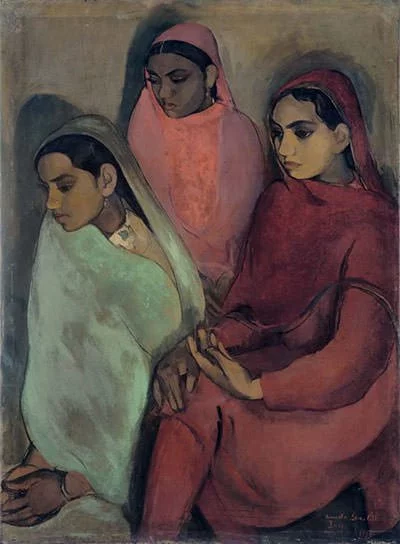
Other Famous Works:-
Self-Portrait (1930)
Brahmacharis (1937)
#2 MAQBOOL FIDA HUSAIN
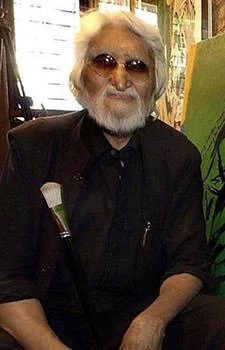
Lifespan: September 17, 1915 – June 9, 2011
In his early years, M. F. Husain used to paint billboards for the Mumbai film industry. In 1947, he became a founding member of the Progressive Artist’s Group in Bombay, which included many prominent names in Indian art. Husain went on to became a highly successful artist and he became known as “Picasso of India”. Husain is most known for his bold and vibrantly colored narrative paintings in a modified Cubist style. His art captures a wide variety of subjects including Mahatma Gandhi; Mother Teresa; the Ramayana; the Mahabharata; the British raj; and motifs of Indian urban and rural life. Also, he frequently captured the spirit of horses in his artworks. In 1991, M. F. Husain was awarded the Padma Vibhushan. His later works however caused a controversy as they depicted traditional deities of India in non-traditional ways including nude portrayals. Due to this Husain lived in self-imposed exile from 2006 until his death. M. F. Husain was the most celebrated and internationally recognized Indian artist of the 20th century.
Masterpiece: Horses (1960)
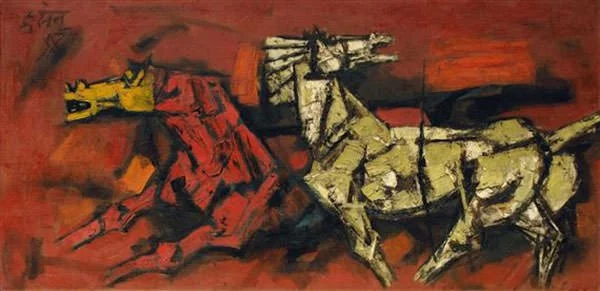
Other Famous Works:-
Mother Teresa (1989)
Mahabharata Series
#1 RAJA RAVI VARMA
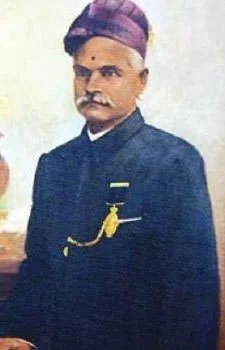
Lifespan: April 29, 1848 – October 2, 1906
Born into an aristocratic family, Ravi Varma learned the basics of painting in Madurai. He was later trained in water painting by Rama Swami Naidu and in oil painting by Dutch portraitist Theodor Jenson. Ravi Varma went on to employ the latest European academic art techniques of the day while focusing on the tradition and aesthetics of Indian art. His works are regarded as among the best examples of the fusion of European techniques with a purely Indian sensibility. Varma also made affordable lithographs of his paintings, making them available to the public. This in turn enhanced his reach and reputation as a painter. The most famous paintings of Ravi Varma are episodes from the Indian epic Mahabharata like the story of Dushyanta and Shakuntala; and Nala and Damayanti. His depictions of Hindu deities and portrayals of the mythological characters from Indian epics are also very renowned. Raja Ravi Varma is considered one of the greatest painters in the history of Indian art; and he is the most famous Indian artist.
Masterpiece: Shakuntala (1870)

Other Famous Works:-
Stolen Interview (1906)
Woman Holding a Fruit (1900)
Discover more from ReviewFitHealth.com
Subscribe to get the latest posts sent to your email.
